

Catalysts for Fine Chemical Synthesis: Hydrolysis, Oxidation and Reduction. Volume 1 Edited by Stan M Roberts and Geraldine Poignant Copyright 2002 John Wiley & Sons, Ltd. ISBN: 0-471-98123-0
12Asymmetric Hydrogenation of Carbon±Carbon Double Bonds Using Organometallic Catalysts
CONTENTS
12.1 |
Introduction . . . . . . . . . . . . . . . . . . . . |
176 |
|
12.2 |
Hydrogenation of dimethyl itaconate using [Rh((S,S)-Me-BPE)]. . . . . |
177 |
|
12.3 |
Hydrogenation of an a-amidoacrylate using |
|
|
|
[Rh((R,R)-Me-DuPHOS)] . . . . . . . . . . . . . . . . . |
179 |
|
12.4 |
Hydrogenation of an a-amidoacrylate using [Rh(B[3.2.0]DPO)] |
|
|
|
complexes . . . . . . . . . . . . . . . . . . . . . |
180 |
|
|
12.4.1 |
Preparation of (COD)2Rh‡BF4ÿ . . . . . . . . . . . . . |
180 |
|
12.4.2 |
Preparation of the bisphosphinite ligand . . . . . . . . . . . |
182 |
|
12.4.3 |
Asymmetric reduction of a-acetamido cinnamic acid . . . . . . . |
184 |
12.5 |
Hydrogenation of enol carbonates and 4-methylene-n-acyloxazolidinone |
|
|
|
using [Rh((R)-BiNAP)] complexes . . . . . . . . . . . . . . |
186 |
|
|
P.H. Dixneuf, C. Bruneau and P. Le gendre |
|
|
|
12.5.1 |
Synthesis of (S)-4,4,5-trimethyl-1,3-dioxolane-2-one . . . . . . . . |
186 |
|
12.5.2 |
Synthesis of (S)-2-methyl-2,3-butanediol . . . . . . . . . . . |
187 |
|
12.5.3 |
Preparation of optically active N-acyloxazolidinones . . . . . . . |
188 |
|
12.5.4 |
Synthesis of (R)-N-propionyl-4,5,5-trimethyl-1,3-oxazolidin-2-one . . . |
189 |
12.6 |
Enantioselective ruthenium-catalyzed hydrogenation of |
|
|
|
vinylphosphonic acids . . . . . . . . . . . . . . . . . |
190 |
|
|
V. Ratovelomanana-vidal, J.-P. GenEt |
|
|
|
|
à |
|
|
12.6.1 |
Synthesis of chiral Ru(II) catalysts . . . . . . . . . . . . . |
190 |
|
12.6.2 Asymmetric hydrogenation of vinylphosphonic acids carrying a |
|
|
|
|
phenyl substituent at C2 . . . . . . . . . . . . . . . . |
191 |
|
12.6.3 Asymmetric reduction of a vinylphosphonic acid |
|
|
|
|
carrying a naphthyl substituent at C2 . . . . . . . . . . . . |
192 |
|
12.6.4 |
Scope of the hydrogenation reaction . . . . . . . . . . . . |
193 |
12.7 |
Synthesis of a cylindrically chiral diphosphine and asymmetric |
|
|
|
hydrogenation of dehydroamino acids |
|
|
|
Jahyo Kang and Jun Hee Lee . . . . . . . . . . . . . . . |
194 |
|
|
12.7.1 |
Preparation of (R,R)-1,10-bis(a-hydroxypropyl) ferrocene . . . . . . |
195 |
|
12.7.2 |
Preparation of (R,R)-1,10-bis[a-(dimethylamino) propyl]ferrocene . . . |
196 |
12.7.3Preparation of (R,R, pS, pS)-1,10-bis[a-(dimethylamino)propyl]-
2,20-bis(diphenyl-phosphino)ferrocene . . . . . . . . . . . . 197
12.7.4Preparation of (R,R,pS, pS)-1,10-bis[a-acetoxypropyl)-2,20
-bis(diphenyl-phosphino)ferrocene . . . . . . . . . . . . . |
198 |
12.7.5 Preparation of (pS, pS)-1,10-bis(diphenylphosphino)-2,20-bis |
|
(1-ethylpropyl)ferrocene [(S,S)-3-Pt-FerroPHOS] . . . . . . . . |
199 |

176 |
hydrolysis, oxidation and reduction |
12.7.6Preparation of [(COD) Rh((pS, pS)-1,10-bis(diphenylphosphino)-
2,20-bis(1-ethylpropyl)ferrocene]‡BFÿ4 . . . . . . . . . . . . 200
12.7.7 |
Asymmetric hydrogenation of a-acetamido cinnamic acid . . . . . . |
201 |
|
12.8 Synthesis and application of diamino FERRIPHOS as ligand for |
|
||
enantioselective Rh-catalysed preparation of chiral a-amino acids |
|
||
Matthias Lotz, Juan J. Almena Perea and Paul Knochel. . . . . . . |
202 |
||
12.8.1 |
Synthesis of 1,10-di(benzoyl)ferrocene . . . . . . . . . . . . |
202 |
|
12.8.2 |
Synthesis of (S,S)-1,10 |
-bis(a-hydroxyphenylmethyl)ferrocene . . . . . |
204 |
12.8.3 |
Synthesis of (S,S)-1,10 |
-bis(a-acetoxyphenylmethyl)ferrocene . . . . . |
205 |
12.8.4 |
Synthesis of (S,S)-1,10 |
-bis(a-N,N-dimethylaminophenylmethyl) ferrocene . |
206 |
12.8.5 |
Synthesis of (aS, a0S) ÿ 1, 10-bis(a-N, |
|
|
|
N-dimethylaminophenylmethyl)-(R,R)-1,10bis(diphenylphosphino) |
|
|
|
ferrocene . . . . . . . . . . . . . . . . . . . . |
207 |
|
12.8.6 Asymmetric hydrogenation of methyl-(Z)-3-phenyl-2-methyl- |
|
||
|
carboxamido-2-propenoate using diamino Ferriphos as chiral ligand . . |
209 |
|
References . . . . . . . . . . . . . . . . . . . . . . . |
210 |
||
12.1INTRODUCTION
Acrylic acid derivatives were chosen as substrates in the early studies on asymmetric hydrogenation of olefins. The additional coordinating functionality such as an amido, carboxyl, amidomethyl, carbalkoxymethyl or hydrocarbonylmethyl group is a prerequisite for getting higher enantioselectivities. Concerning
the synthesis of enantiomerically pure a-amino acids, chiral rhodium±diphosphines[1±3] or ruthenium-[4] catalysts were found to give good results for the
enantioselective hydrogenation of a-(acetamido)acrylates a-(enamides) (Figure 12.1). In this section catalytic hydrogenation methods using ligands based on chiral templates, such as [1,2-bis(phospholano)benzene] (DuPHOS), [1,2- (bisphospholano)ethane] (BPE) and 3,6-bis[bis(4-fluorophenyl)-phosphinoxy]- bicyclo[3.2.0]-heptane (B [3.2.0]DPO) will be described.
R1 |
|
|
|
COR3 [M*], H2 |
R1 |
|
COR3 |
R1 |
COR3 |
|
|
|
|
|
|
|
|
|
|
or |
|
|
|
|
|
|
|
|
|
|
|
|
|
|
|
|
|
|
|
|
|
|
|
R2 |
|
|
|
NHAc |
R2 |
|
NHAc |
R2 |
NHAc |
|
Figure 12.1 Asymmetric hydrogenation of a-enamides.
One of the possible catalytic cycles (i.e. for olefin hydrogenation) is described in Figure 12.2. The molecular hydrogen is first complexed to the metal. Then the olefin is complexed and inserted into the M±H bond. The alkane is liberated by elimination and the catalyst regenerated.
Extreme caution must be taken whenever hydrogen gas and active catalyst are used. Never allow naked flames in the vicinity when hydrogen is being used. Avoid the formation of air±hydrogen mixtures. Any electrical apparatus in the vicinity must be spark-proof. It is far better for the apparatus to be kept in a separate room specially designed for hydrogenation [5].

asymmetric hydrogenation of carbon±carbon double bonds 177
|
|
H |
|
|
L*nM |
|
|
H |
C |
H |
H |
C |
|
L*nM |
L*nM |
|
H |
|
|
|
H |
|
|
|
|
L*nM |
C C |
|
H2 |
H |
H |
|
Figure 12.2 Mechanism of olefin hydrogenation by transition metal complexes.
12.2 HYDROGENATION OF DIMETHYL ITACONATE USING [Rh((S,S)-Me-BPE)][6]
CO2Me |
[(COD)Rh((S,S)Me-BPE)] |
CO2Me |
|
CO2Me |
H2, MeOH |
|
CO2Me |
|
|
||
|
P |
Me |
Me |
|
|
|
|
|
Rh |
|
|
|
P |
|
|
|
|
P |
P |
|
|
Me |
Me |
P =(S,S)-Me-BPE
P
Materials and equipment
. Dimethyl itaconate, 177 mL, 200 mg, 1.26 mmol
.(S,S)-1,2-bis(10,40-Dimethylphospholano)ethane(cyclooctadiene)rho- dium(I): [(COD)Rh(S,S)-Me-BPE], 0.7 mg, 1.26 mmol, 0.1 mol%*
* The catalyst [(COD)Rh((S,S)-Me-BPE)] was kindly provided by Dr M. Burk (Chirotech Technology Limited, Cambridge UK).
178 hydrolysis, oxidation and reduction
. Anhydrous methanol degassed for 20 minutes with nitrogen, 5 mL
. Ethyl acetate, diethyl ether
. Silica gel 60 (0.063±0.04 mm)
. 10 mL Glass liner adapted to the high pressure reactor
. Magnetic stirrer hot plate with a thermostatically controlled oil-bath and thermometer
. 25 mL High pressure reactor
The reaction can be performed at atmospheric pressure using a lowpressure hydrogenation apparatus fitted with a gas burette system.
Procedure
1.A 10 mL glass liner equipped with a magnetic stirrer bar was dried in an oven at 120 8C overnight, cooled in a desiccator under vacuum and then flushed with nitrogen.
2.The liner was filled under nitrogen with dimethyl itaconate (177 mL, 200 mg)
and the catalyst [(COD)Rh(S,S)-Me-BPE] (0.7 mg) and then placed in a 25 mL high pressure reactor.
3.The reactor was flushed six times with hydrogen (the bomb was pressurized at 200 psi, then the gas inlet was closed before the hydrogen was slowly vented off). Degassed anhydrous methanol (5 mL) was added and the re-
actor was pressurized to an initial pressure of 50 psi H2. The reaction was allowed to stir at 20 8C until no further hydrogen uptake was observed (2 hours).
4.The reaction was followed by chiral GC (SE 30, 100 8C isotherm, nitrogen mobile phase). Rt (dimethyl itaconate): 6.8 min; Rt (dimethyl methylsuccinate): 5.7 min.
5.The reaction was then concentrated and the residue was passed through a short column of silica gel eluting with ethyl acetate±diethyl ether (1:1) to
remove the catalyst. The (S)-dimethyl methylsuccinate does not need any further purification (190 mg, 95 %).
. The ee (95 %) was determined by chiral GC (Lipodex1 E, 25 m, 0.25 mm
|
ID, temperatures: column 75 8C isotherm, |
injector 250 8C, detector |
|||||
|
250 8C, mobile phase helium, sample dissolve in methanol) Rt (R)-enan- |
||||||
|
tiomer: 39.3 min Rt (S)-enantiomer: 41.2 min. |
|
|
|
|
||
. 1H NMR(200 MHz, CDCl3): d3:70 (s, |
3H, |
CO2CH3); |
3.69 (s, |
3H, |
|||
|
CO2CH3); 2.92 (m, 1H, CH); 2.76 |
(dd, |
J 16.5 Hz, |
J 8.2 Hz, |
1H, |
||
|
CHaHb); 2.42 (dd, J 16.5 Hz, J 6.0 Hz, 1H, CHaHb); 1.23 (d, J 7.1 Hz, |
||||||
. |
3H, CH3). |
|
|
ˆ |
|
|
|
IR (CHCl3, cmÿ1): 3031, 2957 (C±H aliphatic), 1727 (C |
O), 1463, 1437, |
||||||
|
|
||||||
|
1353, 1280 (C±O), 1167, 1059, 1007. |
|
|
|
|
|
|
. Mass: calculated for C7H13O4: m/z 161.08138; found [MH]‡161:08154.
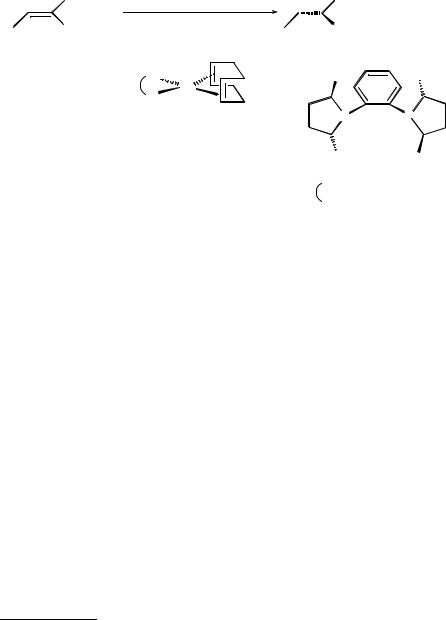
asymmetric hydrogenation of carbon±carbon double bonds 179
12.3 HYDROGENATION OF AN a-AMIDOACRYLATE USING [Rh
((R,R)-Me-DuPHOS)][2]
|
CO2H |
[(COD)Rh((R,R)Me-DuPHOS)] |
|
CO2H |
|
|
Ph |
NHC(O)CH3 |
H2, MeOH |
Ph |
NHC(O)CH3 |
|
|
|
|
|
P |
|
Me |
Me |
|
|
|
Rh |
|
|
|
|
|
|
P |
|
|
|
|
|
|
|
|
P |
P |
|
|
|
|
|
Me |
Me |
P =(R,R)-Me-DuPHOS
P
Materials and equipment
. a-Acetamido cinnamic acid, 259 mg, 1.26 mmol
.(ÿ)-(R,R)-1,2-bis(10,40-dimethylphospholane)benzene(cyclooctadiene)rho- dium (I): [(COD)Rh((R,R)Me-DuPHOS)], 0.8 mg, 1.26 mmol, 0.1 mol%*
This catalyst is commercially available from Strem or Chirotech.
. Anhydrous methanol degassed for 20 minutes with nitrogen, 5 mL
. Ethanol, petroleum ether
. 10 mL Glass liner adapted to the 25 mL high pressure reactor with a magnetic stirrer bar
. 25 mL High pressure reactor
The reaction can be performed at atmospheric pressure using a lowpressure hydrogenation apparatus fitted with a gas burette system.
Procedure
1.A 10 mL glass liner equipped with a magnetic stirrer bar was dried in an oven at 120 8C overnight, cooled in a desiccator under vacuum and then flushed with nitrogen.
2.The liner was filled under nitrogen with acetamido cinnamic acid (259 mg), anhydrous methanol (5 mL) and catalyst [(COD)Rh(R,R)-Me-DuPHOS] (0.8 mg). The liner was placed in a 25 mL high pressure reactor.
3.The reactor was flushed six times with hydrogen (the bomb was pressurized at 200 psi, then the gas inlet was closed before the hydrogen was slowly
vented off) and then pressurized to an initial pressure of 90 psi H2. The
* The catalyst [(COD)Rh((R,R)Me-DuPHOS)] was kindly provided by Dr M. Burk (Chirotech Technology Limited, Cambridge UK)
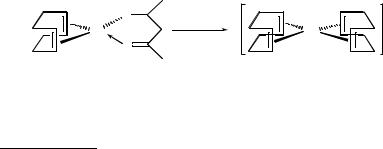
180 |
hydrolysis, oxidation and reduction |
reaction was allowed to stir at 20 8C until no further hydrogen uptake was observed (3 hours).
4.The reaction was followed by chiral GC (SE 30, 220 8C, nitrogen mobile phase). Rt (a-acetamido cinnamic acid): 3.70 min; Rt (N-acetyl-l-phenyl- alanine): 5.4 min.
5.The reaction was concentrated to give a yellow oil (300 mg) which was crystallized with ethanol and petroleum ether to give slightly yellow crystals
(235 mg, 90 %).
The ee (>98 %) was determined by chiral HPLC (Chiralpak1 AD, Hexane-IPA-TFA, 89 %±10 %±1 %, sample dissolved in IPA) Rt (R)-enan- tiomer: 11.9 min, Rt (S)-enantiomer: 14.3 min.
1H NMR(200 MHz, DMSO): d8:25 (d, J 8.2 Hz, 1H, NH); 7.26 (m, 5H, Ph); 4.42 (m, 1H, CH); 3.07 (dd, J 13.7 Hz, J 4.9 Hz, 1H, CHaHb); 2.85 (dd, J 13.7 Hz, J 9.9 Hz, 1H, CHaHb); 1.75 (s, 3H, CO-CH3).
Mass: calculated for C11H13O4N: m/z 207.08954; found [MH]‡ 207.08975.
Conclusion
The procedures using [(COD) Rh (S, S)-Me-BPE] and [(COD) Rh (R,R)-Me- DuPHOS] are very similar; they need a hydrogenation bomb and are conducted under an inert atmosphere, as the catalysts are sensitive to oxygen. They give good results (yield and enantiomeric excess) and hydrogenated products do not need lengthy purification, since no secondary products were detected. The reactions can be carried out under atmospheric pressure giving approximately the same results but need a longer time to be complete. The reaction were stopped when no more hydrogen was consumed; they were generally performed overnight (14 hours). Table 12.1 gives some examples of b, b-disubstituted enamides that can be hydrogenated by those catalysts in similar conditions.
12.4 HYDROGENATION OF AN a-AMIDOACRYLATE USING [Rh(B[3.2.0]DPO)] COMPLEXES
12.4.1PREPARATION OF (COD)2Rh‡BF4ÿ*
O |
COD |
+ |
|
BF4− |
|||
Rh |
Rh |
||
O |
HBF4−OEt2 |
|
Materials and equipment
. [(COD)Rh(acac)], 3.1 g, 10 mmol
. Anhydrous tetrahydrofuran, 60 mL
* Dr. C. Dousson and Dr N. Derrien (University of Liverpool, UK) provided the procedures for the catalyst synthesis and the hydrogenation with Rh(B[3.2.0]DPO)[7].
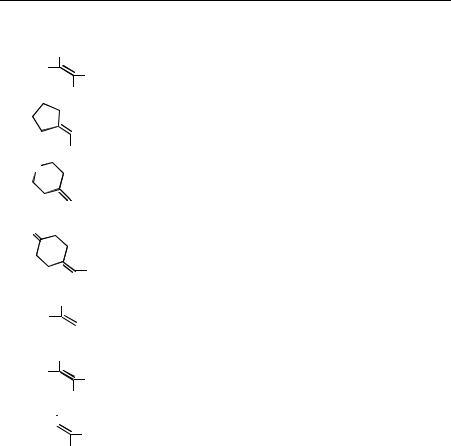
asymmetric hydrogenation of carbon±carbon double bonds 181
. Cycloocta-1,5-diene, 1.30 g, 12 mmol, 1.2 eq
. Tetrafluoroboric acid±diethyl ether complex (HBF4:OEt2) in diethylether, 54 %, 3.00 g, 2.52 mL, 10 mmol, 1 eq, diluted with tetrahydrofuran, 5 mL
. Dry diethyl ether
. 100 mL Schlenk tube with a magnetic stirrer bar.
. Condenser.
. Magnetic stirrer hot plate with a thermostatically controlled oil-bath and thermometer
. Sinter funnel with an inert gas inlet
Table 12.1 Hydrogenation of b, b-disubstituted enamides by [(COD)Rh (S,S)-Me-BPE] and [(COD)Rh (R,R)-Me-DuPHOS] catalysts[2] (results according to the literature).
|
|
|
|
|
|
|
|
|
|
|
|
|
|
|
|
|
|
[Rh(S,S)-Me-DuPHOS] |
[Rh(R,R)-Me-BPE] |
|
|
|
|
|
|
|
|
|
|
|
|
|
|
|
|
|
|
ee % (configuration) |
ee % (configuration) |
|
|
|
|
|
|
|
|
|
|
|
|
|
|
|
|
|
|
|
|
H3C |
|
|
|
|
|
CH3 |
|
|
|||||||||||
|
|
|
|
|
|
||||||||||||||
|
|
|
|
|
|
|
|
|
|
|
|
|
CO2CH3 |
96.0 (S) |
98.2 (R) |
||||
|
|
|
|
|
|
|
|
|
|
|
|
|
|
|
|
||||
|
|
|
|
|
|
|
|
|
|
|
NHCOCH3 |
||||||||
|
|
|
|
|
|
|
|
|
|
|
|
|
|||||||
|
|
|
|
|
|
|
|
|
|
|
|
|
|
CO2CH3 |
96.8 (S) |
97.2 (R) |
|||
|
|
|
|
|
|
|
|
|
|
|
|
|
|
||||||
|
|
|
|
|
|
|
|
|
|
|
NHCOCH3 |
|
|
||||||
S |
|
|
|
|
|
|
|
|
|
|
|
|
|
|
|||||
|
|
|
|
|
|
|
|
|
|
|
|
|
|
CO2CH3 |
95.0 (S) |
98.4 (R) |
|||
|
|
|
|
|
|
|
|
|
|
|
|
|
|
|
|
||||
|
|
|
|
|
|
|
|
|
|
|
NHCOCH3 |
|
|
||||||
O |
|
|
|
|
|
|
|
|
|
|
|
|
|
|
|||||
|
|
|
|
|
|
|
|
|
|
|
|
|
|
|
|
|
CO2CH3 |
93.7 (S) |
98.0 (R) |
|
|
|
|
|
|
|
|
|
|
|
|
|
|
|
|
|
|
|
|
|
|
|
|
|
|
|
|
|
|
|
|
|
|
|
|
|
|
||
|
|
|
|
|
|
|
|
|
|
|
|
NHCOCH3 |
|
|
|||||
C2H5 |
|
|
|
|
|
|
CH3 |
− |
98.2 (2R,3S) |
||||||||||
|
|
|
|||||||||||||||||
|
|
|
|
|
|
|
|
|
|
|
|
|
CO2CH3 |
||||||
|
|
|
|
|
|
|
|
|
|
|
|
|
|
|
|
|
|
|
|
|
|
|
|
|
|
|
|
|
|
|
|
|
NHCOCH3 |
|
|
||||
|
C2H5 |
− |
|
||||||||||||||||
H3C |
|
|
|
|
|
|
|
|
|
|
|
CO2CH3 |
98.3 (2R,3R) |
||||||
|
|
|
|
|
|
|
|
|
|
|
|||||||||
|
|
|
|
|
|
|
|
|
|
|
|
|
|
|
|
|
|||
|
|
|
|
|
|
|
|
|
|
|
|
NHCOCH3 |
|
|
|||||
|
CH3 |
|
|
||||||||||||||||
Ph |
|
|
|
|
|
|
|
|
|
|
CO2CH3 |
99.4 (2S,3R) |
80.1 (2R,3R) |
||||||
|
|
|
|
|
|
|
|
|
|||||||||||
|
|
|
|
|
|
|
|
|
|
|
|
|
|
|
|
||||
|
|
|
|
|
|
|
|
|
|
|
NHCOCH3 |
|
|
||||||
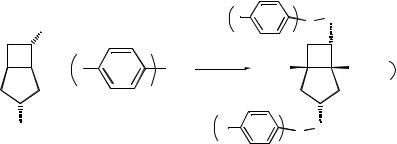
182 |
hydrolysis, oxidation and reduction |
Procedure
1.A 100 mL Schlenk flask equipped with a magnetic stirrer bar and a condenser was dried at 150 8C overnight, cooled under vacuum and then flushed with nitrogen.
2.The Schlenk tube was filled with [(COD)Rh(acac)] (3.1 g) and cycloocta-1,5- diene (1.30 g) which were dissolved in 15 mL of dry tetrahydrofuran. To this orange mixture, the solution of HBF4:OEt2 in tetrahydrofuran (7.52 mL) was added. A brown precipitate appeared, giving a viscous solution, which was diluted with 40 mL additional tetrahydrofuran to allow the reaction to stir efficiently.
3.The orange solution was heated (80 8C) to reflux under nitrogen for 30 minutes.
4.The brown solution was cooled to room temperature. The brown powder was filtered under nitrogen using a sinter funnel with an inert gas inlet, and then washed with dry diethyl ether (3 5 mL).
5.The [(COD)2Rh‡BFÿ4 ] complex obtained was used as the catalyst precursor for hydrogenation without further purification.
12.4.2PREPARATION OF THE BISPHOSPHINITE LIGAND
OH |
|
F |
|
P |
O |
|
|
2 |
|
||
|
|
|
|
||
|
|
THF, NEt3 |
|
|
H = P |
+ 2 F |
PCl |
H |
|
|
|
|
2 |
|
|
|
P |
|
|
|
|
|
|
OH |
|
F |
P |
|
O |
|
|
2 |
|
|
Materials and equipment
. (ÿ)-(1R,3R, 5R, 6S)-Bicyclo[3.2.0]heptan-3,6-diol, 500 mg, 3.9 mmol
. Anhydrous tetrahydrofuran, 20 mL
. Triethylamine, 0.87 g, 8.6 mmol, 2.2 eq
. Bis(4-fluorophenyl)chlorophosphine, 2.2 g, 8.6 mmol, 2.2 eq
Chlorophosphines need to be manipulated carefully with gloves and eye protection. They can cause burns, irritation to eyes and irritation to the respiratory system.
asymmetric hydrogenation of carbon±carbon double bonds 183
Different chlorophosphines can be synthesised, or are available from Strem or Digital Chemicals.
. Alumina, activated overnight at 150 8C
. Two 100 mL Schlenk tubes with magnetic stirrer bars
. Ice-bath
. Sinter funnel with an inert gas inlet
Procedure
1.Two 100 mL Schlenk flasks, each equipped with a magnetic stirrer bar, were dried at 150 8C overnight, cooled under vacuum and then flushed with nitrogen.
2.One of the Schlenk tubes was filled with (ÿ)-(1R, 3R, 5R, 6S)-bicyclo [3.2.0] heptan-3,6-diol (500 mg) dissolved in dry tetrahydrofuran (20 mL) under nitrogen, then triethylamine (0.87 g) was added.
3.The solution was cooled to 0 8C in an ice-bath, and then the chlorophosphine (2.2 g) was added dropwise via a syringe over 5 minutes with stirring. A white precipitate of triethylammonium chloride appeared. When the addition was complete, the ice-bath was removed and the stirring was continued at ambient temperature for 15 hours.
4.A sinter funnel with nitrogen inlet connected to the second dry Schlenk tube was filled with a pad of activated alumina which was cooled under vacuum and then flushed with nitrogen. The precipitate was filtered off through the pad of alumina under nitrogen. The solvent was removed under vacuum from the second Schlenk tube.
5.The solvent was removed in vacuo to give the bisphosphinite ligand (1R, 3R, 5R, 6S)-3,6-bis[bis(40-fluorophenyl) phosphinooxy] bicyclo [3.2.0] heptane as a white solid (1.99 g, 90 %).
The ligands prepared by this method were sufficiently pure for use as an in situ catalyst preparation.
NMR 13C (50 MHz, CDCl3): d 30.16 (s, C1); 33.80 (d, 3JPC 5.4 Hz, C4), 37.04 (d, 3JPC 6.5 Hz, C7), 40.88 (d, 3JPC 4.8 Hz, C2); 45.43 (d, 3JPC 4.8 Hz C5); 69.98 (d, 2JPC 16.3 Hz, C6); 84.78 (d, 2JPC 17.7 Hz, C3); 115.18±116.88
(m, C30 , C50 , C300 , C500 ); 131.89±133.87 (m, C02, C06, C002 , C006 ); 136.99±137.83 (m, C10 , C100 ); 163.54, 163.63, 163.71, 163.77 (4 d, 1JFC 247 Hz, C40 , C400 ).
NMR 31P (162 MHz, CDCl3): d 103.30 (s), 105.03 (s).
Mass: calculated for C31H26F4O2P2: m/z 568.13446; found [M]‡ 568.13466.
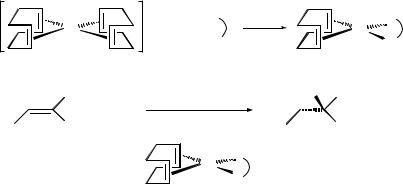
184 |
hydrolysis, oxidation and reduction |
12.4.3 ASYMMETRIC REDUCTION OF a-ACETAMIDO CINNAMIC ACID
|
|
+ |
|
|
|
|
Rh |
BF − |
P |
MeOH |
Rh P |
|
+ |
|
|||
|
|
4 |
P |
|
P |
|
|
|
|
||
|
|
|
|
|
|
|
CO2H |
MeOH,H2 |
H |
CO2H |
|
Ph |
NHC(O)CH3 |
|
|
Ph |
NHC(O)CH3 |
|
|
|
Rh |
P |
|
|
|
|
|
|
|
|
|
|
|
P |
|
Materials and equipment
. (1R, 3R, 5R, 6S)-3, 6-Bis [bis (40-fluorophenyl) phosphinoxy] bicyclo [3.2.0] heptane, 6.7 mg, 0.012 mmol, 1 mol%
. Anhydrous methanol degassed with nitrogen, bubbling for 1 hour, 30 mL (COD)2Rh‡BFÿ4 , 5.25 mg, 0.013 mmol, 1.1 mol%
The catalyst is not stable in solution and cannot be stored for a long time.
. a-Acetamido cinnamic acid, 240 mg, 1.17 mmol
. 25 mL Schlenk tube with a magnetic stirrer bar
. Syringes
. High pressure reactor, 50 mL.
. Glass liner adapted to high pressure reactor with a magnetic stirrer bar
Procedure
1. A 25 mL Schlenk tube equipped with a magnetic stirrer bar was dried at 150 8C overnight, cooled under vacuum and then flushed with nitrogen.
2.The Schlenk tube was filled with bisphosphinite ligand, (1R, 3R, 5R, 6S)-3,6- bis [bis (40-fluorophenyl) phosphinooxy] bicyclo[3.2.0]heptane (6.7 mg), de-
gassed methanol (3 mL) and (COD)2Rh‡BFÿ4 (5.25 mg). The reaction mixture was stirred at room temperature until all the material was dissolved (10± 15 minutes) giving an orange solution.
3.A glass liner of a 50 mL hydrogenation bomb was charged with a-acetamido cinnamic acid (240 mg) and a magnetic stirrer bar. The bomb was then assembled, flushed five times with hydrogen (the bomb was pressurized at 200 psi, then the gas inlet was closed before the hydrogen was slowly vented off).
